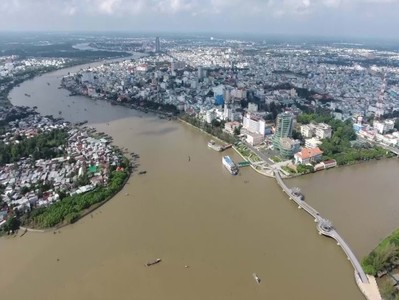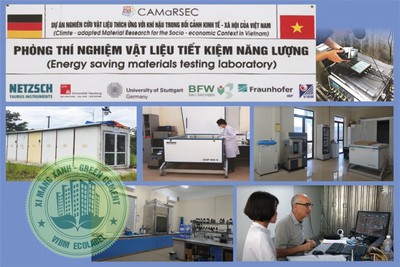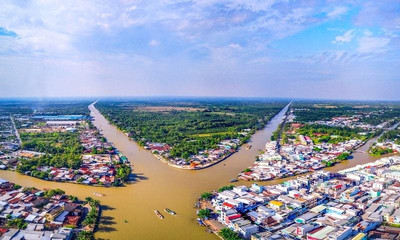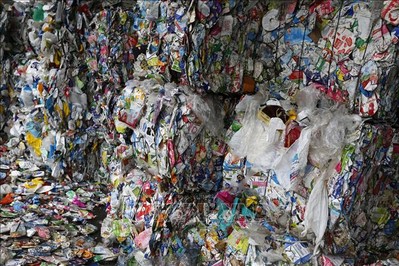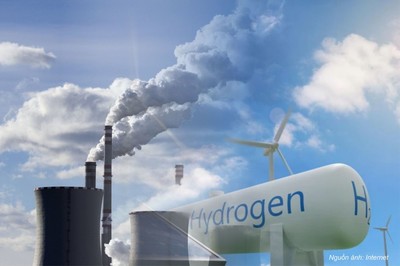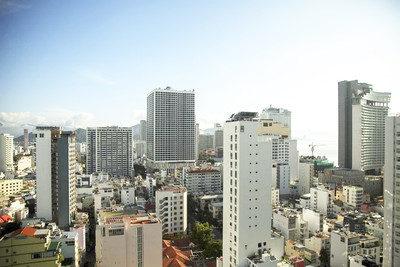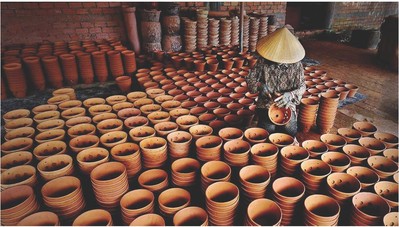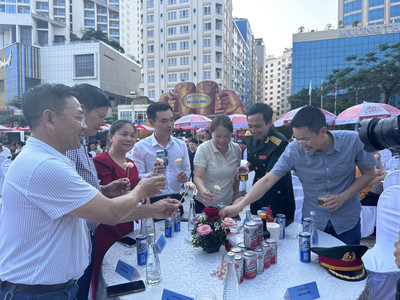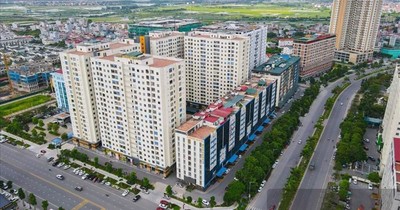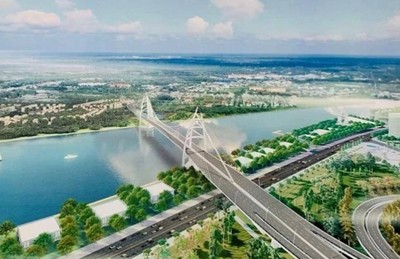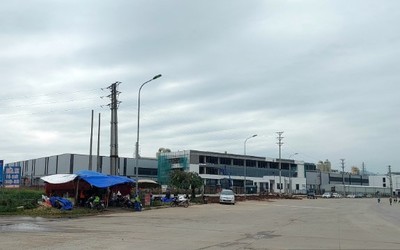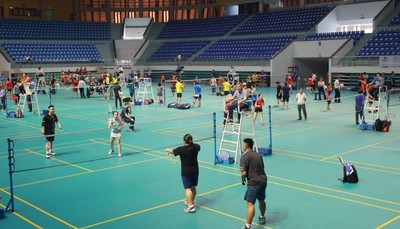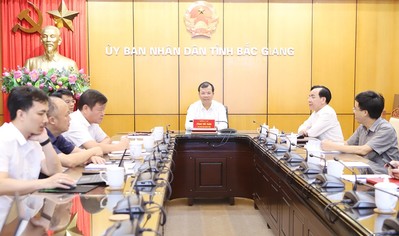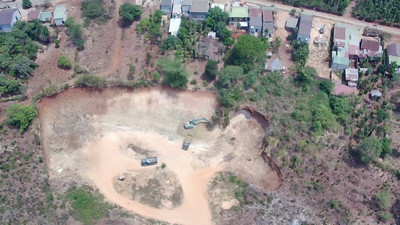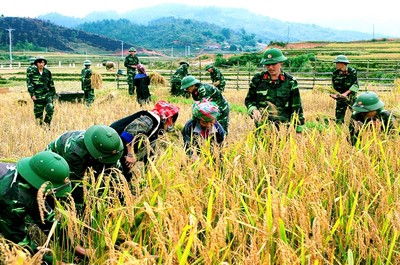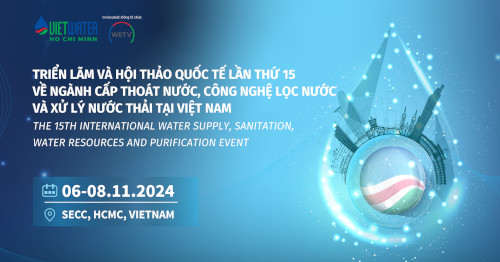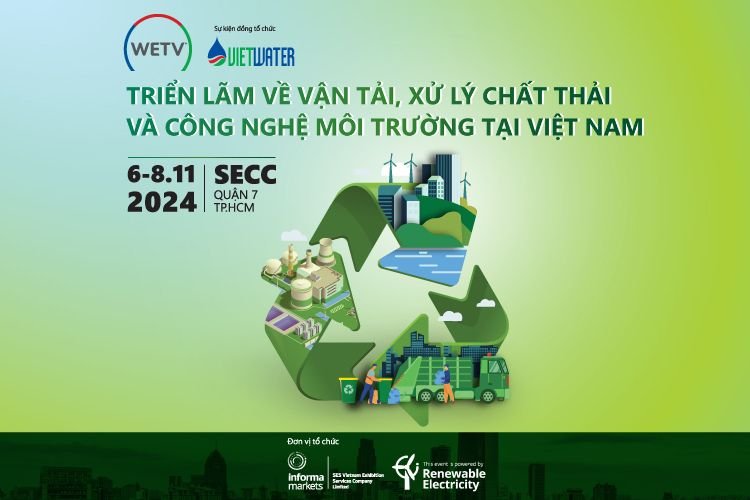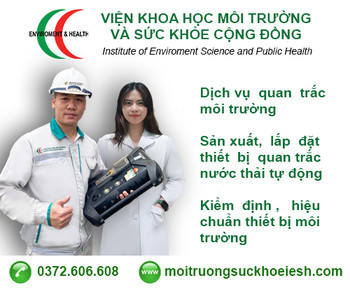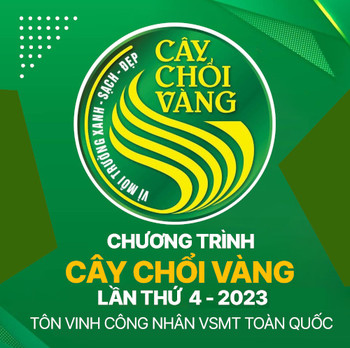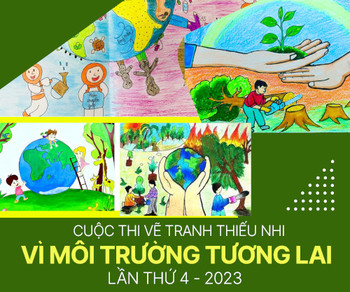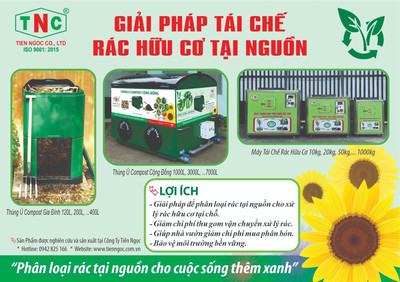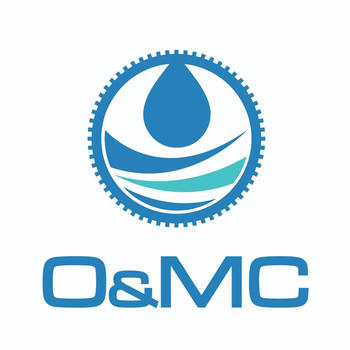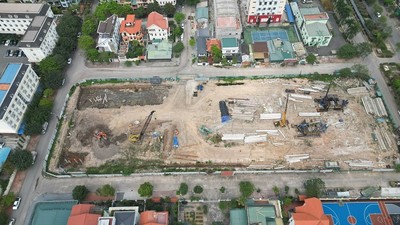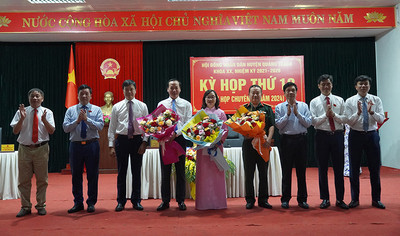Công bố quốc tế lĩnh vực môi trường số 44-2023
Trân trọng giới thiệu tới quý độc giả Công bố quốc tế Công bố quốc tếsố 44-2023.
Về quản lý môi trường
- Tác động của biến đổi khí hậu đến hiện trạng sinh thái các dòng sông: Trường hợp Thung lũng Albaida (Đông Nam Tây Ban Nha).
- Con đường dẫn đến một tương lai bền vững: Điều tra sự đóng góp của đổi mới công nghệ, năng lượng sạch và trao quyền cho phụ nữ trong việc giảm thiểu các thách thức môi trường toàn cầu.
- Những thay đổi về thông số suy thoái môi trường ở Bangladesh: Vai trò của tiết kiệm ròng, cạn kiệt tài nguyên thiên nhiên, đổi mới công nghệ và dân chủ.
- Cục Dự trữ Liên bang có thể cứu được môi trường không ?
- Hiểu biết sâu sắc về việc thu hồi tài nguyên và năng lượng bền vững từ nước rỉ rác theo hướng giảm thiểu phát thải để quản lý môi trường: Một cách tiếp cận quan trọng.
- Tác động trực tiếp và tương tác của quản lý môi trường chiến lược và thực hành trách nhiệm xã hội đối với lợi thế của sản phẩm mới.
- Chuyển đổi công nghiệp xanh: Tận dụng đổi mới môi trường và thuế môi trường để đạt được mức trung hòa carbon. Mở rộng trên mô hình STRIPAT.
- Lực lượng truyền thông về biến đổi khí hậu có hành xử nhất quán trước và sau khi mục tiêu "cacbon kép” được đưa ra không? Sự khác biệt không gian-thời gian dựa trên weibo.
- Có thể sản xuất số lượng lớn vật liệu nào khi chuyển sang trạng thái phát thải ròng bằng 0 vào năm 2050 với nguồn tài nguyên phát thải bằng 0 hạn chế ?
- Biến đổi sinh khí hậu trên toàn mạng lưới khu bảo tồn của Phần Lan.
Về môi trường đô thị
- Các nguồn khí dung mịn tại một địa điểm nền đô thị ở Đông Địa Trung Hải (Nicosia; Síp): Những hiểu biết sâu sắc từ việc so sánh phân bổ nguồn ngoại tuyến và trực tuyến đối với các khí dung cacbonat.
- Phát triển mô hình tạo chuyến đi vận chuyển hàng hóa bằng cách sử dụng thông tin được quan sát và không được quan sát về các đặc điểm của chuỗi cung ứng để chuyển đổi đô thị bền vững.
- Gia tăng nguy cơ mắc bệnh lây truyền từ chuột ở các khu đô thị xanh hơn.
- Phân bổ nguồn khí Nitrophenol và sự đóng góp của chúng vào sự hình thành HONO ở khu vực đô thị.
- Nhu cầu nước của Hạ tầng đô thị xanh dưới tác động của biến đổi khí hậu.
- Bạn nên sưởi ấm ngôi nhà của mình như thế nào trong quá trình chuyển đổi năng lượng xanh? Phương pháp ra quyết định đa tiêu chí dựa trên kịch bản.
- Các loại không gian xanh đô thị ảnh hưởng đến sự tập hợp quần thể vi sinh vật và kháng kháng sinh trong thực vật nhiều hơn trong đất.
- Khử phức và khoáng hóa đồng bộ các phức đồng bằng cách hoạt hóa peroxymonosulfate với than sinh học lưỡng kim từ có nguồn gốc từ bùn thải đô thị.
Về môi trường khu công nghiệp
- Số phận của hạt vi nhựa trong một nhà máy xử lý nước thải hóa dầu điển hình.
- Chất rắn sinh học của nhà máy bột giấy giảm thiểu phát thải khí nhà kính trong đất từ việc sử dụng urê và cải thiện độ phì nhiêu của đất trong đồn điền cây dương lai.
- Hiện đại hóa chính sách chung về ô nhiễm khói mù từ dữ liệu lớn đăng ký doanh nghiệp: Tác động không gian của các hoạt động công nghiệp.
- Đánh giá việc sử dụng năng lượng mặt trời trong ngành dệt may của Iran hướng tới sản xuất sạch hơn: Lập kế hoạch bền vững và phân tích tính khả thi.
- Hướng tới tương lai ít carbon cho ngành dầu khí ngoài khơi: Hệ thống quản lý năng lượng tích hợp thông minh với tua bin gió và tua bin khí nổi.
- Những thách thức và tiến bộ trong quá trình kết tinh chưng cất màng cho các ứng dụng công nghiệp.
- Vai trò của quy định môi trường và vốn nhân lực xanh đối với phát triển bền vững: Vai trò trung gian của đổi mới xanh và nâng cấp ngành công nghiệp.
- Than sinh học biến tính hạt nano magie oxit có nguồn gốc từ bã chè để tăng cường khả năng hấp phụ o-chlorophenol từ nước thải công nghiệp.
- Chất chuyển hóa môi trường phát hiện ra stress oxy hóa, rối loạn điều hòa axit amin và suy giảm năng lượng ở Daphnia magna khi tiếp xúc với nước thải công nghiệp.
- Ý nghĩa của các chính sách dệt tuần hoàn đối với quy định tương lai về các chất độc hại trong hàng dệt ở Liên minh Châu Âu.
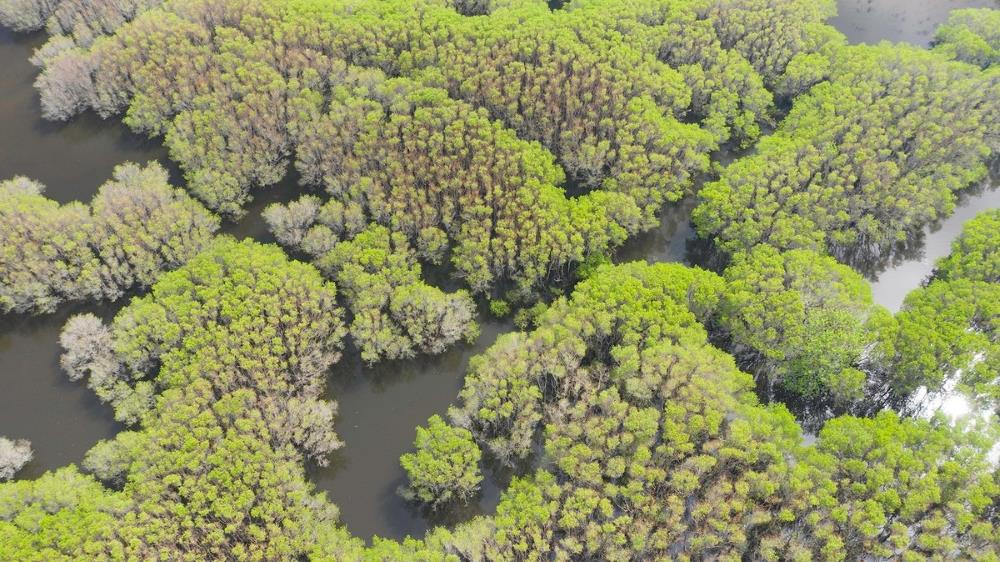
CHUYÊN TRANG QUẢN LÝ MÔI TRƯỜNG
Tạp chí Môi trường và Đô thị Việt Nam
Trân trọng giới thiệu:
The Environmental Management Special Section is pleased to present to our valued readers the International Environmental Bulletin No. 44/2023, featuring the following key topics:
ENVIRONMENTAL MANAGEMENT / QUẢN LÝ MÔI TRƯỜNG
1. Climate change impact on the ecological status of rivers: The case of Albaida Valley (SE Spain)
Science of The Total Environment, Volume 893, 1 October 2023, 164645
Abstract
Understanding the effects of environmental stressors (e.g., potential changes in climate and land use) on ecological status is essential for freshwater management. The ecological response of rivers to stressors can be evaluated by several physico-chemical, biological, and hydromorphological elements as well as computer tools. In this study, an ecohydrological model based on SWAT (Soil and Water Assessment Tool) is used to investigate climate change impact on the ecological status of Albaida Valley Rivers. The predictions of five General Circulation Models (GCMs) each with four Representative Concentration Pathways (RCPs) are employed as input to the model for simulating several chemical and biological quality indicators (nitrate, ammonium, total phosphorus, and the IBMWP (Iberian Biological Monitoring Working Party) index) in three future periods (Near Future: 2025–2049, Mid Future: 2050–2074, and Far Future: 2075–2099). Based on chemical and biological status predicted with the model, the ecological status is determined at 14 representative sites. As a result of increased temperatures and decreased precipitations from most of GCMs projections, the model predicts decreased river discharge, increased concentrations of nutrients, and decreased values of IBMWP for future compared to the baseline period (2005–2017).
While most representative sites have poor ecological status (10 sites with poor ecological status and four sites with bad ecological status) in the baseline, our model projects bad ecological status for most representative sites (four sites with poor ecological status and 10 sites with bad ecological status) under most emission scenarios in the future.
It should be noted that the bad ecological status is projected for all 14 sites under the most extreme scenario (i.e., RCP8.5) in the Far Future. Despite the different emission scenarios, and all possible changes in water temperature and annual precipitation, our findings emphasize the urgent need for scientifically informed decisions to manage and preserve freshwaters.
2. A pathway to a sustainable future: Investigating the contribution of technological innovations, clean energy, and Women's empowerment in mitigating global environmental challenges
Journal of Cleaner Production, Volume 421, 1 October 2023, 138499
Abstract
This study aims to provide insights into the pathway toward a sustainable future by investigating the factors contributing to environmental sustainability. In this pursuit, the current study empirically analyzes the role of economic growth, technological innovation, clean energy consumption, and women empowerment toward global environmental quality from 1991 to 2015. For empirical analysis, autoregressive distributive lag and fourier frequency domain causality models are employed to test the long-medium and short-run association between the selected variables.
Fully modified ordinary least squares and canonical cointegration regression estimations are also applied for robustness. The empirics of this study reveal that economic growth deteriorates the environmental quality in the long and short run. However, technological innovation, clean energy consumption, and women's empowerment help improve environmental quality in the long and short run. In addition, the robust analysis also authenticates the long-run outcomes of the study.
This study suggests policy recommendations aimed at a sustainable future by establishing strong regulatory policy instruments, enforcing environmental laws, promoting energy-efficient technologies in industries and households, implementing women's employment protection policies, and strong regulatory policy instruments to achieve emission reduction in the global perspective.
3. Changes in environmental degradation parameters in Bangladesh: The role of net savings, natural resource depletion, technological innovation, and democracy
Journal of Environmental Management, Volume 343, 1 October 2023, 118190
Abstract
Most researchers consider CO2 emissions to be the primary indicator of environmental degradation. Similarly, ecological footprint appears to be a significant proxy for environmental degradation in recent research due to its multifaceted impact on the natural environment. With this in mind, this study investigates fluctuations in CO2 emissions and ecological footprint as indicators of environmental degradation in Bangladesh from 1980 to 2020, and how they are influenced by net savings, natural resource depletion, technological innovation, and democracy.
The non-linear ARDL (NARDL)-based asymmetric analysis finds that positive changes in net savings, natural resource depletion, and democracy positively impact both parameters of environmental degradation in the long run. On the other hand, a positive change in technological innovation reduces these parameters in the long run. Likewise, negative changes in net savings and technological innovation reduce environmental degradation. In contrast, negative changes in natural resource depletion and democracy exacerbate these two parameters and degrade environmental quality in the long run. However, there are some variations in the short-run influence of the predictors on the predicted variable. Overall, the findings of this study suggest that policymakers must strategically exploit natural resources, net savings, technology diffusion, and democratic principles to preserve the natural environment in Bangladesh.
4. Can the Federal Reserve save the environment?
Journal of Cleaner Production, Volume 423, 15 October 2023, 138730
Abstract
This study examines the environmental effect of monetary policy, particularly within the framework of global value chains (GVCs). Given the escalating climate concerns and the urgent need for sustainable solutions, it is crucial to investigate the environmental consequences of monetary policy decisions which directly influence domestic production and international input-sourcing activities. As the monetary policy is likely to be associated with a variety of economic factors influencing environmental outcomes, it is critical to introduce an exogenous shock that reflects variations in monetary policies to derive unbiased causal estimates.
We thus adopt a proxy-vector autoregression (VAR) approach with U.S. monetary policy surprise as an exogenous instrument. We uncover compelling evidence that one standard deviation of contractionary monetary policy surprise leads to a reduction in overall emissions by approximately 0.5 percent. However, the more significant and concerning result is the observed rise in emission intensities by 0.2 percent.
We highlight the key mechanism underlying this outcome: higher domestic credit costs discourage firms from effectively outsourcing production tasks abroad, thereby increasing the generation of air pollutants per unit of output arising from reduced production efficiency. The identification of a previously unrecognized environmental externality calls for a reevaluation of policy approaches and underscores the importance of integrating environmental considerations into monetary policy frameworks.
5. Insights into sustainable resource and energy recovery from leachate towards emission mitigation for environmental management: A critical approach
Journal of Environmental Management, Volume 343, 1 October 2023, 118219
Abstract
The exponential generation of municipal solid waste (MSW) and landfill disposal without any treatment has increased the continuous generation of landfill leachate. Improper MSW and leachate management are contributing to environmental degradation and water and soil pollution, which must be treated. Numerous works have been conducted on leachate treatments for energy and resource recovery.
This review presents a comprehensive study of leachate management in which different treatment methods are discussed to analyze the suitability of processes that can be employed to treat leachate efficiently. Further, the characteristics of leachate are examined as properties of leachate may be varied depending upon the region. Still, several challenges related to leachate management and its treatments are discussed in this study. An integrated system could be a better option for treating leachate because it contains large amounts of organic and inorganic compounds. Proper leachate management would help to recover energy and value-added products (metals).
6. The direct and interacting effects of strategic environmental management and socially responsible practices on new product advantage
Journal of Cleaner Production, Volume 421, 1 October 2023, 138510
Abstract
A substantial body of literature has shown the relationship between corporate sustainability (CS) and firm performance, but the effects of individual CS practices on new product advantage (NPA) remain ambiguous. Drawing on stakeholder theory and relevant CS literature, the purpose of this study is to investigate the direct and interacting effects on NPA of four CS practices, namely, strategic environmental management (SEM), CS management control, safety climate, and community relationship management.
Our study method involved a multi-respondent questionnaire survey of 198 Chinese manufacturers, and we statistically verified the survey data to test the research model with three hypotheses. The findings of this study show that all CS practices can directly improve NPA. We found that, in affecting NPA, SEM interacts positively with CS management control, negatively with community relationship management, and not at all with safety climate. Our findings provide new evidence to prioritize and balance the efforts of CS practices on new product performance. They also primarily clarify the conflicting or unclear relationships among the four CS practices for new product development (NPD).
7. Green industrial transition: Leveraging environmental innovation and environmental tax to achieve carbon neutrality. Expanding on STRIPAT model
Journal of Environmental Management, Volume 343, 1 October 2023, 118121
Abstract
Anthropogenic global warming strategies on carbon mitigation are driven by encouraging green innovation and using carbon taxes, yet an empirical model to validate this is non-existing. Moreover, the existing stochastic effects by regression on population, wealth, and technology (STIRPAT) model has been found to lack policy tools on taxes and institutions that cut carbon emissions.
This study amends the STIRPAT model with environmental technology, environmental taxes, and strong institutional frameworks to create a new model STIRPART(stochastic impacts by regression on population, affluence, regulation, and technology) to understand the factors impacting carbon pollution using the emerging 7 economies. Using data from 2000 to 2020, the Driscoll-Kraay fixed effects are employed in this analysis to conduct evidential tests of the impacts of environmental policies, eco-friendly innovations, and strong institutions.
The outcomes indicate that environmental technology, environmental taxation, and institution quality decrease E7's carbon emissions by 0.170%, 0.080%, and 0.016%, respectively. It is recommended that E7 policymakers should adopt the STIRPART postulate as the theoretical basis for policies favoring environmental sustainability. The key contribution is the amendment of the STIRPAT model and the enhancement of the market-based mechanisms, such as patents, strong institutions, and carbon taxes, to enable environmental policy to be carried out sustainably and cost-effectively.
8. How asymmetric is the response of CO2 emissions to economic restructuring in China? Evidence from NARDL approach
Journal of Cleaner Production, Volume 423, 15 October 2023, 138836
Abstract
China has experienced a remarkable economic progression since the implementation of its reform and opening-up policy. Yet, it is crucial to confront the challenge of achieving sustainable and high-quality economic growth while concurrently enhancing environmental quality. This study adopts the nonlinear autoregressive distributed lag (NARDL) approach to explore how economic structure adjustments impacted China's carbon dioxide (CO2) emissions from 1980 to 2020.
The empirical results reveal some asymmetries in the influence of agricultural progression, industrial development, and foreign direct investment (FDI) on CO2 emissions in short and long-term contexts. Specifically, in the long run, a 10% positive change in agricultural development increases CO2 emissions by 1.55%, nearly double the mitigation effect of a negative change (0.78%); a 10% positive (negative) change in industrialization is associated with a 0.6% decrease (0.23% increase) in CO2 emissions; a 10% positive change in FDI results in a 2.30% increase in CO2 emissions, supporting the "Pollution Haven" hypothesis, while a 10% negative change contributes to a 4.51% increase.
In the short run, a 10% negative change in agricultural and industrial sectors increases CO2 emissions by 0.27% and 0.21%, respectively, while a 10% negative change in FDI leads to a 2.0% increase in CO2 emissions. Additionally, short-term positive changes in agricultural and industrial sectors and positive shocks in FDI exert negligible influence on CO2 emissions. These findings highlight the necessity of economic structure transformation and refinement of current environmental policies.
9. Optimal pathways for upgrading China's wastewater treatment plants for achieving water quality standards at least economic and environmental cost
Journal of Environmental Management, Volume 344, 15 October 2023, 118397
Abstract
Wastewater treatment plants (WWTPs) in China must be upgraded to meet new discharge standards, but this incurs both economic and environmental costs and benefits. To select the optimal upgrade pathway, we developed ten upgrade paths based on two common decision-making scenarios for WWTP upgrade in developing countries. Using model simulation, life-cycle assessment, life-cycle cost, and multiple-attribute decision-making, we incorporated the full costs and benefits associated with the construction and operation into the decision-making process.
We used a weighting scheme of attributes for the three regions and ranked the upgrade paths using the technique for order preference by similarity to an ideal solution (TOPSIS). The results showed that constructed wetlands and sand filtration were advantageous in terms of lower economic costs and environmental impacts, while the denitrification filter pathways required less land. Optimal pathways differed by region, highlighting the importance of a detailed and integrated assessment of the costs and benefits of WWTP upgrade options over the full life cycle. Our findings can inform decision-making on upgrading China's WWTPs to meet stringent discharge standards and protect inland water and coastal environments.
10. Does the climate change communication power behave consistently before and after the "dual carbon” target is put forward? Spatial-temporal differences based on Weibo
Journal of Cleaner Production, Volume 421, 1 October 2023, 138435
Abstract
Climate change communication power is an important variable to characterize the influence of climate change information. To deeply understand the public's climate change communication power in China under the "dual carbon” context, this study selected Weibo as the source for obtaining climate change texts and analyzed the spatial-temporal differences of climate change communication power by using a web crawler and a communication power model.
Through the comparative analysis of the two periods before and after the "dual carbon” goal was put forward, it is found that: (1) After the "dual carbon” goal was put forward, the public's discussion on climate change was more widely distributed, which formed a concerned circle of climate change in coastal areas, but the extensive discussion on climate change did not mean the enhancement of climate change communication. (2) Celebrities play an important role in the communication of climate change, but users with strong communication power for climate change do not mean that the amount of forwarding must be high. (3) The communication power of climate change is generally in a state of fluctuation, and economically developed areas have stronger communication power. (4) Keywords such as "carbon footprint” and "green technology” are the most powerful in the situation after the "dual carbon” goal was put forward. Based on the comparative analysis, the study grasps the role orientation and division of labor as a whole, which will provide a basis for formulating regional climate change-related policies more pertinently. The introduction of z-index into the study of climate change transmission in Weibo is an innovation in the application scenario of z-index.
11. What bulk material production is possible on a transition to net zero emissions by 2050 with limited zero emissions resources?
Journal of Cleaner Production, Volume 423, 15 October 2023, 138346
Abstract
Global production of bulk materials such as steel, paper, and aluminium has tripled over the past three decades and decarbonising their production is a difficult challenge. The transition to net zero emissions depends on three key zero emissions resources, non-emitting electricity, biomass, and carbon storage. This paper develops a model to anticipate how likely deployment of these three resources will constrain bulk material production on the transition to net zero emissions by 2050. The results predict that 2050 supply of steel, paper and aluminium will be up to 40% lower than demand. To address this shortfall, policy should promote a more rapid deployment of zero emissions resources in parallel with the strategies of material demand reduction.
Synopsis
This paper quantifies potential production levels of aluminium, steel and paper on a trajectory that achieves net zero emissions by 2050 given constraints on zero emissions resources.
12. A 50-year systemic review of bioavailability application in Soil environmental criteria and risk assessment
Environmental Pollution, Volume 335, 15 October 2023, 122272
Abstract
Bioavailability has become a critical factor in improving ecological risk assessment and environmental remediation efficiency in contaminated soil research. However, the soil environmental quality standards and risk assessment procedures used in most countries are still based on the total amount of pollutants for lacking sufficient understanding of the exposure pathways and action mechanisms of pollutants. we collected relevant literature from the Web of Science database, spanning the period from 1950 to 2021 by using Citespace to analyze the scientific development of bioavailability. As of January 09, 2022, the database contained 118,813 publications on bioavailability.
The review summarizes the progress in bioavailability research and emerging trends, including exploring advanced analytical techniques, advancing modeling approaches, and integrating interdisciplinary approaches to better understand the fate and behavior of pollutants in complex environmental matrices. In particular, the review emphasizes the need for better integration of bioavailability concepts into soil environmental reference, risk assessment procedures, and environmental remediation strategies. Overall, this review emphasized the necessity of incorporating the concept of bioavailability into soil environmental reference, risk assessment procedures, and environmental remediation strategies.
13. The impact of natural resource management, innovation, and tourism development on environmental sustainability in low-income countries
Resources Policy, Volume 86, Part B, October 2023, 104088
Abstract
Natural resource depletion and the effects of global warming on the environment have emerged as urgent worldwide challenges. Many countries have responded by implementing plans to manage their natural resources and deal with environmental issues in the post-COVID-19 era. However, innovative abilities are frequently limited in low-income countries (LICs), which makes it difficult for them to successfully offset environmental consequences. It is crucial to comprehend the possible contributions that innovation, tourism, and the availability of natural resources can make to resolving these issues.
This study focuses on examining how innovation, tourism, and environmental degradation relate to LICs richness of natural resources. To establish the reliability of the results, empirical analysis utilizing data from 2000 to 2020 of LICs was carried out using the Feasible GLS, Prais-Winsten Regression, Driscoll-Kraay standard error regression, and Non-Parametric Kernel regression models.
The findings show that natural resources have a beneficial effect on environmental degradation in LICs. Natural resource-dependent sectors are thought to use energy-intensive procedures, which contribute to greater emissions, in countries where the share of natural resource rent in GDP is higher. Higher levels of innovation may not always result in environmental sustainability in LICs, as the study also demonstrates a positive association between innovation and environmental degradation. Although there is a link between tourism and environmental deterioration, it is possible that the growth of tourism in LICs will encourage the transition to a less carbon-intensive service-based economy.
14. Reducing SDG complexity and informing environmental management education via an empirical six-dimensional model of sustainable development
Journal of Environmental Management, Volume 344, 15 October 2023, 118328
Abstract
Effective environmental management higher education programs are essential for achieving the Sustainable Development Goals (SDGs). Yet SDG complexity means many educators focus on environment and avoid critical but challenging social, economic and governance aspects.
This undermines the calls for comprehensive environmental management education that effectively integrates all key sustainability dimensions. Various sustainability models, mostly founded on the pillars of sustainability, have consequently evolved. They are generally conceptual and/or involve subjective categorization of the SDGs, which has led to demands for more empirically based models. This study has consequently used a mixed-method approach to model Australian university students’ SDG perceptions.
The qualitative research identified three items (on average) for each SDG, and a quantitative survey then measured their perceived importance. Factor analysis generated a robust six-dimensional sustainable development model comprised of 37 SDG items, which validates environment and governance aspects of some traditional pillar-based sustainability models. It has also uncovered new social and economic dimensions: social harmony and equality; sustainable consumption and socioeconomic behaviors; sustainable production, industry and infrastructure; and acute poverty reduction. These findings can help educators, organizations and citizens to categorize and integrate SDGs via better understanding of their key dimensions and impacts.
15. Evaluating the role of the share and intensity of renewable energy for sustainable development in Germany
Journal of Cleaner Production, Volume 421, 1 October 2023, 138482
Abstract
With its strong ties to the European Union, Germany is well-positioned to assist many countries achieve sustainability goals. Therefore, the main objective of this paper is to examine how renewable energy intensity and renewable energy share improve environmental sustainability, the load capacity factor (LCF) in Germany from 1970 to 2018. To this end, the study uses the autoregressive distributed lag model, with the effects of the Kyoto Protocol included as a dummy variable.
The study contributes to the literature by considering and testing for the first time the impact of renewables on the LCF in terms of intensity and share for Germany. The empirical results show that (i) economic growth lowers the LCF faster in the early stages of economic development than in later periods; therefore, the environmental Kuznets curve hypothesis is valid in Germany. (ii) A 1% upsurge in renewable energy intensity has no statistically significant effect on the LCF, while a 1% rise in the share of renewables in the total energy mix increases LCF by 0.48%. (iii) A 1% rise in urbanization reduces the LCF by 6.52%. (iv) A 1% augment in human capital enhances the LCF by 3.49%. These outcomes suggest that the German government should use human capital development and increasing the share of renewable energy as policy instruments to achieve the sustainable development goals.
16. Bioclimate change across the protected area network of Finland
Science of The Total Environment, Volume 893, 1 October 2023, 164782
Abstract
Protected areas (PAs) are crucial in conserving biodiversity under climate change. In boreal regions, trends of biologically relevant climate variables (i.e., bioclimate) in PAs have remained unquantified. We investigated the changes and variability of 11 key bioclimatic variables across Finland during the period 1961–2020 based on gridded climatology.
Our results suggest significant changes in annual mean and growing season temperatures over the entire study area, whereas, e.g., annual precipitation sum and April–September water balance have increased especially in the central and northern parts of Finland. We found substantial variation in bioclimatic changes over the 631 studied PAs; in the northern boreal zone (NB) the number of snow-covered days has decreased on average by 5.9 days between 1961–1990 and 1991–2020, while in the southern boreal zone (SB) the corresponding decrease has been 16.1 days.
The number of frost days in spring with absent snow cover has decreased in the NB (on average −0.9 days) while increasing in the SB (0.5 days), reflecting the changing exposure of biota to frost. The observed increases in accumulation of heat in the SB and more frequent rain-on-snow events in the NB can affect drought tolerance and winter survival of species, respectively. Principal component analysis suggested that the main dimensions of bioclimate change in PAs vary across vegetation zones; for example, in the SB the changes are related to annual and growing season temperatures, whereas in the middle boreal zone the changes are linked to altered moisture and snow conditions. Our results highlight the substantial spatial variation in bioclimatic trends and climate vulnerability across the PAs and vegetation zones. These findings provide a basis for the understanding of the multifaceted changes the boreal PA network is facing and help to develop and direct conservation and management.
URBAN ENVIRONMENT/ MÔI TRƯỜNG ĐÔ THỊ
1. Fine aerosol sources at an urban background site in the Eastern Mediterranean (Nicosia; Cyprus): Insights from offline versus online source apportionment comparison for carbonaceous aerosols
Science of The Total Environment, Volume 893, 1 October 2023, 164741
Abstract
A total of 348 daily PM2.5 samples were collected at an urban background site of Nicosia, capital of Cyprus, for one-year period (October 2018–October 2019) to assess the origin and sources of fine PM at the Eastern Mediterranean, a poorly characterized area of the world.
The samples were analysed for water soluble ionic species, elemental and organic carbon, carbohydrates and trace metals, the combination of which were utilized to identify pollution sources by applying Positive Matrix Factorization (PMF). Six PM2.5 sources, namely long-range transport (LRT; 38 %), traffic (20 %), biomass burning (16 %), dust (10 %), sea salt (9 %) and heavy oil combustion (7 %), were identified.
Despite sampling in an urban agglomeration, the chemical fingerprint of the aerosol is largely dictated by air mass origin rather than local sources. Springtime is characterized by the most elevated particulate levels due to the southerly air masses carrying particles from the Sahara Desert. Northerlies are observed throughout the year but are predominant during summer allowing the LRT source to peak (54 % during summer). Only during winter, due to extensive use of biomass combustion for domestic heating (36.6 % during winter), local sources dominate.
A co-located online PMF source apportionment of submicron carbonaceous aerosols (Organic Aerosols, OA; Black Carbon) was performed by the means of an Aerosol Chemical Speciation Monitor (for OA) and an Aethalometer (for BC) for a four-month period. The comparison between the two methodologies allowed to better assess the robustness and limitations of the two methodologies.
More specifically, LRT OA and biomass burning BC apportioned by the offline PMF showed a strong consistency with the online apportioned more oxidized oxygenated OA and BCwb, respectively; cross validating these sources. On the other hand, our traffic factor may contain additional hydrocarbon-like OA and BC from fossil fuel sources other than just vehicular emissions. Finally, the offline biomass burning OA source is likely to contain both primary and secondary OA.
2. Characteristics of ambient air quality and its air quality index (AQI) model in Shanghai, China
Science of The Total Environment, Volume 896, 20 October 2023, 165284
Abstract
Long-term observations indicate that, the ambient air quality in Shanghai continues to improve, however the synergistic effects between the air pollutants PM2.5, O3 and NO2 are also increasing. The concentration of chemical components included in PM2.5 is higher in moderately polluted air containing multiple pollutants.
This suggests that air pollution metrics based on multi-pollutant synergy are more descriptive of ambient air quality than single-pollutant air quality index (AQI) models that may ignore the effect of synergy between pollutants on ambient air quality forecasts. Therefore, this study proposes a new multi-pollutant air quality index model (NMAQI) based on four air pollutants (PM2.5, SO2, NO2 and O3) that emphasizes the relationship between PM2.5, NO2 and O3 in ambient air.
The model successfully categorized observational data into classes of good, moderate, and polluted air quality ratings. Verification of the NMAQI model using the PM2.5 chemical composition spectrum shows that the NMAQI model can more accurately classify samples with high concentrations of chemical components (often misclassified by AQI) into high pollution levels. The model has an improved capacity to assess the degree of pollution in urban ambient air and to reduce the risk of public exposure to highly polluted atmospheric environments.
3. Development of freight trip generation model using observed and unobserved information of supply chain characteristics for a sustainable urban transformation
Journal of Cleaner Production, Volume 421, 1 October 2023, 138500
Abstract
Supply Chain Characteristics (SCC) drive the city logistics to control the economic activities that support urban life and transformation. The dynamics of freight trip activity and SCC in city logistics are less understood by city planners, disrupting the prediction of urban Freight Trip Generation (FTG) models. To develop robust urban FTG models, the present study introduces the concept of estimating the freight trip activity using observed and unobserved (subjective) information of SCC for sustainable urban transport movement. Traditionally, the objective variable excludes the unobserved information of SCC while developing the FTG model; this gap can be addressed by incorporating subjective variables to measure both observed and unobserved information of SCC.
A unique framework was designed by a combination of objective and subjective variables through Exploratory Factor Analysis (EFA) and Structural Equation Modelling (SEM) to estimate the freight trip activity. An Establishment Based Freight Survey (EBFS) collected from an Indian smart city (1793 samples) comprising various SCC was used to test the developed framework. Deployed EFA can identify the subjective variables using latent constructs to explain the observed and unobserved information in the SCC.
Then, sequential execution of SEM with hypothesis path structure for estimating the freight trip activity. The direct, indirect, and total effects of the FTG model revealed added advantage of causal inter-relationship of urban freight trip activity and SCC between intermediate and pure receiver establishment. The developed FTG models using observed and unobserved information of SCC predicted freight trip activity with an accuracy of 57% for intermediate and 63% for pure receiver establishment. The effect of SSC on freight trip activity aids in creating sustainable urban freight transportation that could be an agile, responsive, and flexible adaptive system for the global market demand.
4. Increased rat-borne zoonotic disease hazard in greener urban areas
Science of The Total Environment, Volume 896, 20 October 2023, 165069
Abstract
Urban greening has benefits for both human and environmental health. However, urban greening might also have negative effects as the abundance of wild rats, which can host and spread a great diversity of zoonotic pathogens, increases with urban greenness. Studies on the effect of urban greening on rat-borne zoonotic pathogens are currently unavailable. Therefore, we investigated how urban greenness is associated with rat-borne zoonotic pathogen prevalence and diversity, and translated this to human disease hazard. We screened 412 wild rats (Rattus norvegicus and Rattus rattus) from three cities in the Netherlands for 18 different zoonotic pathogens: Bartonella spp., Leptospira spp., Borrelia spp., Rickettsia spp., Anaplasma phagocytophilum, Neoehrlichia mikurensis, Spiroplasma spp., Streptobacillus moniliformis, Coxiella burnetii, Salmonella spp., methicillin-resistant Staphylococcus aureus (MRSA), extended-spectrum beta-lactamase (ESBL)/AmpC-producing Escherichia coli, rat hepatitis E virus (ratHEV), Seoul orthohantavirus, Cowpox virus, severe acute respiratory syndrome coronavirus 2 (SARS-CoV-2), Toxoplasma gondii and Babesia spp.
We modelled the relationships between pathogen prevalence and diversity and urban greenness. We detected 13 different zoonotic pathogens. Rats from greener urban areas had a significantly higher prevalence of Bartonella spp. and Borrelia spp., and a significantly lower prevalence of ESBL/AmpC-producing E. coli and ratHEV. Rat age was positively correlated with pathogen diversity while greenness was not related to pathogen diversity. Additionally, Bartonella spp. occurrence was positively correlated with that of Leptospira spp., Borrelia spp. and Rickettsia spp., and Borrelia spp. occurrence was also positively correlated with that of Rickettsia spp.
Our results show an increased rat-borne zoonotic disease hazard in greener urban areas, which for most pathogens was driven by the increase in rat abundance rather than pathogen prevalence. This highlights the importance of keeping rat densities low and investigating the effects of urban greening on the exposure to zoonotic pathogens in order to make informed decisions and to take appropriate countermeasures preventing zoonotic diseases.
5. Source apportionment of gaseous Nitrophenols and their contribution to HONO formation in an urban area
Chemosphere, Volume 338, October 2023, 139499
Abstract
Nitrophenols (NPs) have significant impacts on human health, climate, and atmospheric chemistry. Despite numerous measurements of particulate NPs, still little is known about their gaseous atmospheric abundances, sources, and fate. Here, four gaseous NPs [2,4-dinitrophenol (2,4-DNP), 4-nitrophenol (4-NP), 2-nitrophenol (2-NP), and 2-Methyl-4-nitrophenol (2-Me-4-NP)] were continuously monitored during late Spring at an urban site in Houston, Texas. Among the four NPs, 4-NP showed the highest abundance, followed by 2-Me-4-NP, 2-NP, and 2,4-DNP with average concentrations of 1.07 ± 0.19 ppt, 0.47 ± 0.12 ppt, 0.41 ± 0.16 ppt, and 0.27 ± 0.09 ppt, respectively. The positive matrix factorization (PMF) model identified seven sources: industrial NPs, secondary formation, phenol sources, acetonitrile source, natural gas/crude oil, traffic, and petrochemical industries/oil refineries.
A zero-dimensional photochemical box model was used to simulate the observed 2-NP and 2,4-DNP. A 50.0% and 70.0% jNO2 was found to be consistent with the measured 2-NP and 2,4-DNP. This yields a nitrous acid (HONO) production of 7.5 ± 2.5 ppt/h from 06:00 to 18:00 Central Standard Time (CST) from both NPs. An extrapolation including other known NPs suggests a maximum HONO formation of 13.8 ppt/h. The results of this study suggest that using PMF analysis supplemented by photochemical box model provides identification of the NPs sources and their atmospheric implication to HONO formation.
6. Water requirement of Urban Green Infrastructure under climate change
Science of The Total Environment, Volume 893, 1 October 2023, 164887
Abstract
The increased uncertainty of rainfall and high urban temperatures resulting from climate change present challenges for water management in Urban Green Infrastructure (UGI). UGI is an important component of cities, and it plays a crucial role in addressing various environmental issues (e.g., floods, pollutants, heat islands, etc.). Effective water management of UGI is essential to ensure its environmental and ecological benefits in the face of climate change. However, previous studies have not adequately investigated water management strategies for UGI under climate change scenarios. This study aims to estimate the current and future water requirement and effective rainfall (rainwater stored in the soil and plant roots available for plant evapotranspiration) to determine the irrigation requirement of UGI during periods of rainfall deficit under current and future climate conditions.
The results indicate that the water requirement for UGI will continue to increase under both RCP4.5 and RCP8.5 climate scenarios, with a larger increase projected under RCP8.5. For instance, the average annual water requirement for UGI in Seoul, South Korea is currently 731.29 mm, and it is projected to increase to 756.45 mm (RCP4.5) and 816.47 mm (RCP8.5) during the period of 2081–2100, assuming low managed water stress condition. In addition, the water requirement of UGI in Seoul is the highest in June (approximately 125–137 mm) and the lowest in December or January (about 5–7 mm). While irrigation is unnecessary in July and August due to sufficient rainfall, other months in Seoul require irrigation when rainfall is insufficient. For example, continuous insufficient rainfall from May to June 2100 and April to June 2081 would need >110 mm (RCP4.5) of irrigation requirement even under high managed water stress condition. The findings of this study provide a theoretical foundation for water management strategies in current and future UGI settings.
7. What establishes citizens' household intention and behavior regarding municipal solid waste separation? A case study in Jiangsu province
Journal of Cleaner Production, Volume 423, 15 October 2023, 138642
Abstract
Management of municipal solid waste in China requires special attention because China has become the world's largest producer of municipal solid waste, and the overall volume of municipal solid waste produced is still increasing. Recently, local and central Chinese authorities have significantly enhanced municipal solid waste treatment. Therefore, this current study aims to extend the theory of interpersonal behavior with perceived benefits to assess citizens' household municipal solid waste separation intention and behavior in Jiangsu province.
This study will help widen and improve the comprehension of the key factors affecting citizens' household municipal solid waste separation. Utilizing data from 615 sampled citizens in Jiangsu, analysis was conducted using partial least squares structural equation modeling. Empirical evidence revealed that affect, attitude, and social factors positively influence citizens' household municipal solid waste separation intentions. Perceived benefits also positively impact citizens' household municipal solid waste separation intentions via attitude. Facilitating conditions influence citizens' household municipal solid waste separation intentions and behaviors.
The study also found that facilitating conditions negatively moderated the association between intention and behavior in Jiangsu Province. Habits significantly and positively influenced and moderated citizens' household municipal solid waste separation intentions and behaviors. These findings provide great insights and contributions to pro-environmental research and can be applied to various provinces that value household municipal solid waste separation in China.
10. Critical analysis on the transformation and upgrading strategy of Chinese municipal wastewater treatment plants: Towards sustainable water remediation and zero carbon emissions
Science of The Total Environment, Volume 896, 20 October 2023, 165201
Abstract
In the light of circular economy aspects, processing of large-scale municipal wastewater treatment plants (WWTPs) needs reconsideration to limit the overuse of energy, implement of non-green technologies and emit abundant greenhouse gas. Along with the huge increase in the worldwide population and agro-industrial activities, global environmental organizations have issued several recent roles to boost scientific and industrial communities towards sustainable development. Over recent years, China has imposed national and regional standards to control and manage the discharged liquid and solid waste, as well as to achieve carbon peaking and carbon neutrality. The aim of this report is to analyze the current state of Chinese WWTPs routing and related issues such as climate change and air pollution.
The used strategies in Chinese WWTPs and upgrading trends were critically discussed. Several points were addressed including the performance, environmental impact, and energy demand of bio-enhanced technologies, including hydrolytic acidification pretreatment, efficient (toxic) strain treatment, and anaerobic ammonia oxidation denitrification technology, as well as advanced treatment technologies composed of physical and chemical treatment technologies, biological treatment technology and combined treatment technology. Discussion and critical analysis based on the current data and national policies were provided and employed to develop the future development trend of municipal WWTPs in China from the construction of sustainable and "Zero carbon” WWTPs.
11. How should you heat your home in the green energy transition? A scenario-based multi-criteria decision-making approach
Journal of Cleaner Production, Volume 421, 1 October 2023, 138398
Abstract
The choice of heating system is significant for city planners and building owners alike, and many important areas, such as the well-being of residents, climate change impact and resource efficiency, may influence the choice. Understanding how to balance these areas is crucial for effective decision-making that can contribute to sustainable development and the green energy transition. However, these decisions represent complex problems where disparate knowledge areas must be considered simultaneously.
When faced with this type of decision-making problem, employing different multi-criteria decision-making methods is common. However, such methods only provide a snapshot of which alternative is preferred and because of this, their results may become obsolete due to changes in the performance of alternatives or the value perceptions of the decision-makers. To overcome this challenge and to improve the longevity and reliability of multi-criteria decision-making results, the authors of this study explored a novel approach to producing semi-dynamic results through scenarios, which were used to consider possible future changes to the alternatives' performance and the decision-makers’ value perceptions.
The application of scenarios in the multi-criteria decision-making method enabled nuanced information to be produced on how the performance of different heating alternatives may change under different plausible futures. This approach was demonstrated by applying it to the case of residential heating in Denmark, where results showed that while final rankings varied across both scenarios and ranking methods, solar heating was the preferred alternative, while the oil boiler alternative performed the worst. Overall, this study highlights the importance of considering likely future changes to both the performance of alternatives and the value perceptions of decision-makers when making decisions with long lifetimes and suggests an approach for doing this.
12. Urban greenspace types influence the microbial community assembly and antibiotic resistome more in the phyllosphere than in the soil
Chemosphere, Volume 338, October 2023, 139533
Abstract
Urban greenspace (UGS) is recognized to confer significant societal benefits, but few studies explored the microbial communities and antibiotic resistance genes (ARGs) from different urban greenspace types. Here, we collected leaf and soil samples from forest, greenbelt, and parkland to analyze microbial community assembly and ARG profile. For phyllosphere fungal community, the α-diversity was higher in forest, compared to those in greenbelt and parkland. Moreover, urban greenspace types altered the community assembly. Stochastic processes had a greater effect on phyllosphere fungal community in greenbelt and parkland, while in forest they were dominated by deterministic processes. In contrast, no significant differences in bacterial community diversity, community assembly were observed between the samples collected from different urban greenspace types.
A total of 153 ARGs and mobile genetic elements (MGEs) were detected in phyllosphere and soil with resistance to the majority classes of antibiotics commonly applied to humans and animals. Structural equation model further revealed that a direct association between greenspace type and ARGs in the phyllosphere even after considering the effects of all other factors simultaneously. Our findings provide new insights into the microbial communities and antibiotic resistome of urban greenspaces and the potential risk linked with human health.
13. City-level environmental performance and the spatial structure of China's three coastal city clusters
Journal of Cleaner Production, Volume 422, 10 October 2023, 138591
Abstract
Cities' environmental efficiency (measured in terms of green total factor productivity, GTFP) have been found in the existing literature to correlate spatially. However, the spatial structure of the interrelations between cities' GTFP have not yet been determined. In this study, we attempted to characterize city-level spatial networks of GTFP by investigating China's major three coastal city clusters: Jing-Jin-Ji (JJJ), Yangtze River Delta (YRD), and Pearl River Delta (PRD).
We estimated the GTFP of 38 cities within these three coastal city clusters by applying a super-efficiency slack-based measure (SBM) within a data envelopment analysis (DEA) approach, constructed a spatial network of GTFP for each city cluster based on gravity model, traced out the centralities and subgroups of each GTFP network by conducting social network analysis, and then investigated the socioeconomic factors correlating to GTFP interrelation between cities.
The results are as follows: First, the average GTFP in the three clusters increased from 2010 to 2021, as did the industrial value added in these regions. In addition, average GTFP increased the most in PRD region relative to the other two clusters. Second, centers of the spatial network of GTFP exist in these three regions. These are as follows: Beijing, Tianjin, and Langfang in JJJ region; Wuxi, Suzhou, and Yangzhou in YRD region; and Guangzhou and Foshan in PRD region. In the JJJ and YRD regions, the composition of the subgroups containing cities with greater closeness of GTFP underwent significant changes between 2010 and 2021, whereas the composition of the subgroup in the PRD region did not change as much.
Third, differences in terms of industrial structure and distance between two cities are key underlying factors that influence the interrelation of GTFP between these cities. The characteristics of the spatial networks of GTFP in the three city clusters imply that improving the balance between the central cities and other noncentral cities to alleviate the misallocations between cities and economic resources could result in an increase in the overall efficiency of economic growth and environmental improvement.
14. Synchronous decomplexation and mineralization of copper complexes by activating peroxymonosulfate with magnetic bimetallic biochar derived from municipal sludge
Chemosphere, Volume 338, October 2023, 139358
Abstract
Efficient removal of copper complexes is a challenging issue due to their robust stability and solubility. In this study, CoFe2O4–Co0 loaded sludge-derived biochar (MSBC), a magnetic heterogeneous catalyst, was prepared to activate peroxymonosulfate (PMS) for the decomplexation and mineralization of some typical copper complexes (including Cu(Ⅱ)-EDTA, Cu(Ⅱ)-NTA, Cu(Ⅱ)-citrate, and Cu(Ⅱ)-tartrate).
The results showed that abundant cobalt ferrite and cobalt nanoparticles were decorated in the plate-like carbonaceous matrix, making it a higher degree of graphitization, better conductivity and more excellent catalytic activity than the raw biochar. Cu(Ⅱ)-EDTA was chosen as the representative copper complex. Under the optimum condition, the decomplexation and mineralization efficiency of Cu(Ⅱ)-EDTA in MSBC/PMS system were 98% and 68% within 20 min, respectively.
The mechanistic investigation confirmed that the activation of PMS by MSBC followed both a radical pathway contributed by SO4•− and •OH and a nonradical pathway contributed by 1O2.
In addition, the electron transfer pathway between Cu(Ⅱ)-EDTA and PMS facilitated the decomplexation of Cu(Ⅱ)-EDTA. Jointly, Cdouble bondO, Co0, and the redox cycles of Co(Ⅲ)/Co(Ⅱ) and Fe (Ⅲ)/Fe (Ⅱ) were found to play a critical role in the decomplexation process. Overall, the MSBC/PMS system provides a new strategy for efficient decomplexation and mineralization of copper complexes.
15. Understanding supply-demand mismatches in ecosystem services and interactive effects of drivers to support spatial planning in Tianjin metropolis, China
Science of The Total Environment, Volume 895, 15 October 2023, 165067
Abstract
Metropolitan areas are being challenged by the disparity between growing societal needs and dwindling natural resource provision. Understanding the supply-demand mismatches of ecosystem services (ES) and their drivers is essential for landscape planning and decision-making. However, integrating such information into spatial planning remains challenging due to the complex nature of urban ecosystems and their intrinsic interactions. In this study, we first assessed and mapped the supply, demand, and mismatches of six typical ES in Tianjin, China. We then clustered numerous townships based on their corresponding spatial characteristic of ES supply-demand mismatches. We also used Random Forest regression to examine the relative importance of drivers and applied Partial Least Squares structural equation modelling to decouple their interactions.
The results showed that, the distribution of ES supply and demand showed obvious spatial heterogeneity, with a common surplus of ES supply in highly natural mountainous region and an excess of demand in urban centre. Additionally, all towns were classified into four spatial clusters with homogeneous states of supply-demand mismatches, serving as basic units for spatial optimization. Moreover, the interactions between drivers affected ES supply-demand mismatches in a coupled manner, including the direct effects of the socioeconomic factor (−0.821) and landscape composition (0.234), as well as the indirect effects of the biophysical factor (0.151) and landscape configuration (0.082). Finally, we discussed the utility of analysing the spatial mismatches between ES supply and demand for integrated territorial planning and coordinated decision-making.
16. Nitrogen addition and drought affect nitrogen uptake patterns and biomass production of four urban greening tree species in North China
Science of The Total Environment, Volume 893, 1 October 2023, 164893
Abstract
Nitrogen (N) is an essential nutrient element limiting plant growth and production, and plant N uptake capacity varies with environmental change. Recently, global climate changes such as N deposition and drought have important impacts on the terrestrial ecosystems, especially for urban greening trees. However, it's still unclear how N deposition and drought affect plant N uptake and biomass production and the underlying relationship between them.
Therefore, we conducted a 15N isotope labeling experiment on four common tree species of urban green spaces in North China, including Pinus tabulaeformnis, Fraxinus chinensis, Juniperus chinensis, and Rhus typhina in pots. Three N addition treatments (0, 3.5, and 10.5 gN m −2 year −1; "no”, "low”, and "high” N treatments, respectively) and two water addition treatments (300 and 600 mm year−1; "drought” and "normal water”, respectively) were set up in a greenhouse.
Our results showed that N and drought significantly affected tree biomass production and N uptake rates, and the relationship between them depended on the species specificity. Trees could transform their N uptake preference to adapt to the changing environment, from ammonium to nitrate or vice versa, which was also reflected in total biomass.
Furthermore, the variation of N uptake patterns was also related to distinct functional traits, including aboveground (specific leaf area and leaf dry matter content) or belowground (specific root length, specific root area, and root tissue density) traits. There was a transformation of plant resource acquisitive strategy in a high N and drought environment. In general, there were tight connections among N uptake rates, functional traits, and biomass production of each target species. This finding comes up with a new strategy that tree species can modify their functional traits and plasticity of the N uptake forms for survival and growth in the context of high N deposition and drought.
INDUSTRIAL AREA ENVIRONMENT / MÔI TRƯỜNG KHU CÔNG NGHIỆP
1. The destiny of microplastics in one typical petrochemical wastewater treatment plant
Science of The Total Environment, Volume 896, 20 October 2023, 165274
Abstract
Microplastic (MP) is a type of emerging contaminant that is verified to be threatening to some organisms. Controlling MP emission from the source is preferred for its refractory characteristic. The petrochemical industry is a possible contributor, responsible for the most plastic production, and wastewater is the most possible sink of MP.
This study applied the Agilent 8700 Laser infrared imaging spectrometer (LDIR) to detect MPs in one typical petrochemical wastewater treatment plant (PWWTP). It was determined that the abundances of MPs in the influent and effluent of the target PWWTP were as high as 7706 and 608 particles/L. The primary treatment removed most MPs (87.5 %) with a final removal efficiency of 92.1 %. 23 types of MPs were identified, and Polyethylene (PE), Polypropylene (PP), Silicone resin prevailed in the effluent. All the MPs were smaller than 483.9 μm. All in all, this study preliminarily unveiled the ignorable status of the petrochemical industry in releasing MPs into the water environment for the first time.
2. Pulp mill biosolids mitigate soil greenhouse gas emissions from applied urea and improve soil fertility in a hybrid poplar plantation
Journal of Environmental Management, Volume 344, 15 October 2023, 118474
Abstract
Pulp mill biosolids (hereafter 'biosolids') could be used as an organic amendment to improve soil fertility and promote crop growth; however, it is unclear how the application of biosolids affects soil greenhouse gas emissions and the mechanisms underlying these effects. Here, we conducted a 2-year field experiment on a 6-year-old hybrid poplar plantation in northern Alberta, Canada, to compare the effects of biosolids, conventional mineral fertilizer (urea), and urea + biosolids on soil CO2, CH4 N2O emissions, as well as soil chemical and microbial properties. We found that the addition of biosolids increased soil CO2 and N2O emissions by 21 and 17%, respectively, while urea addition increased their emissions by 30 and 83%, respectively. However, the addition of urea did not affect soil CO2 emissions when biosolids were also applied.
The addition of biosolids and biosolids + urea increased soil dissolved organic carbon (DOC) and microbial biomass C (MBC), while urea addition and biosolids + urea addition increased soil inorganic N, available P and denitrifying enzyme activity (DEA). Furthermore, the CO2 and N2O emissions were positively, while the CH4 emissions were negatively associated with soil DOC, inorganic N, available phosphorus, MBC, microbial biomass N, and DEA. In addition, soil CO2, CH4 and N2O emissions were also strongly associated with soil microbial community composition. We conclude that the application of the combination of biosolids and chemical N fertilizer (urea) could be a beneficial approach for both the disposal and use of pulp mill wastes, by reducing greenhouse gas emissions and improving soil fertility.
3. Modernizing one-size-fits-all policy for haze pollution from enterprise registration big data: Spatial effects of industry activities
Journal of Cleaner Production, Volume 423, 15 October 2023, 138829
Abstract
Haze pollution is one of the most serious environmental problems in China. In order to promote economic development and protect the environment, the Chinese government has made many attempts. One of them is the one-size-fits-all policy adopted by some local governments in the face of haze pollution, which has disrupted the normal operation of the economy. This study attempts to use the enterprise registration information of Chinese enterprises from 2005 to 2018 to explore the relationship between industrial activities and haze pollution through a spatial econometric model. From a macro perspective, the manufacturing industry and service industry have a significant impact on haze pollution.
From sub-industry perspective, manufacture has a significant impact on haze pollution. The service industries such as accommodation and catering, wholesale and retail, and real estate have a positive impact on haze pollution. We further investigate the sub-manufacture industry and find not all sub-industries increase haze pollution. The one-size-fits-all policy should be modernized into one-industry-one-treatment approach, instead of blindly reducing manufacturing and increasing the service industry. In addition, the urbanization rate has an inverted U-shaped relationship with haze pollution, which supports the EKC hypothesis.
4. Emission reductions, industrial competitiveness, and spillover effects under China's regional emission trading systems: Evidence from the iron and steel sector
Journal of Environmental Management, Volume 344, 15 October 2023, 118481
Abstract
An emission trading system (ETS) has been consistently recognized as a promising instrument to stem massive carbon emissions from energy-intensive industries. However, it remains ambiguous whether the ETS can achieve emission mitigation without undermining economic activity in specific industries in emerging running markets. This study focuses on the impact of China's four independent ETS pilots on carbon emissions, industrial competitiveness, and spatial spillover effects in the iron and steel industry. With a synthetic control method for causal inference, we find that the achievement of emission reductions was generally accompanied by losses of competitiveness in the pilot regions.
An exception to this trend was seen in the Guangdong pilot, where the aggregate emissions increased due to the incentivized output created by a specific benchmarking allocation approach. Despite impaired competitiveness, the ETS did not cause significant spatial spillovers, which alleviates concerns about potential carbon leakage under unilateral climate regulation. Our findings could enlighten subsequent sector-specific assessments of the effectiveness of ETSs and are also valuable to policymakers in and outside China now considering ETSs.
5. Evaluation of using solar energy in Iran's textile industry towards cleaner production: Sustainable planning and feasibility analysis'
Journal of Cleaner Production, Volume 421, 1 October 2023, 138447
Abstract
The use of solar thermal energy is a suitable alternative to fossil fuels, but due to the lack of sufficient information on the implementation of thermal plants, solar industrial process heat (SIPH) was not implemented. The goal of this study is to assess SIPH in the textile industry of Iran. For this purpose, the suitable province for developing SIPH projects is determined from five dimensions using multicriteria decision-making (MCDM) methods. The step-wise weight assessment ratio analysis (SWARA) is used for weighting and the grey measurement alternatives and ranking according to compromise solution (MARCOS-G) is used for prioritizing the provinces.
Then, at the optimum site, the performance of a 5 MW power plant with solar parabolic trough collectors along with the storage system is optimized, and dynamic modeling is done. MCDM results showed that Isfahan is the most suitable province for developing SIPH in Iran's textile industry. The feasibility assessment showed that the levelized cost of heat in the optimal condition is equal to 20.9 $/MWh-t. Also, it has led to the reduction of 4 kt of CO2 emissions. Although the price of natural gas is very cheap in Iran, if the pollution tax policies are applied in Iran, SIPH will be cost-effective in the textile industry.
6. Layer-by-layer investigation of the black box: A case of assessing the industrial water-related system in China
Journal of Environmental Management, Volume 344, 15 October 2023, 118353
Abstract
The essence of efficiency measurement is to model and estimate the performance of a complex system in a comparable form, and the key to modeling is to make the model as close to reality as possible. Based on data envelopment analysis (DEA) methods, this research proposes a layer-by-layer investigation framework for the black box. To illustrate the rationality of this logical framework, this paper presents a triple-opened dynamic recycling model with a series-parallel structure that allows us to assess the efficiency of the industrial water-related system in China.
We obtain and compare the system efficiency under different scenarios for opening the black box. The results show that: (1) China's efforts to improve the performance of the resource use sub-stage through industrial production technology and management have been effective. (2) The performance of China's industrial water-related system strongly relates to the water supply subunit with a positive linear correlation. (3) The water supply subunit is the main foot-dragger in the system, and the government needs to place particular attention on improving the performance of labor in this subunit.
7. Towards a low-carbon future for offshore oil and gas industry: A smart integrated energy management system with floating wind turbines and gas turbines
Journal of Cleaner Production, Volume 423, 15 October 2023, 138742
Abstract
Decarbonizing offshore oil and gas fields is crucial in the global fight against climate change. To achieve this objective, the offshore oil and gas industry has embraced innovative energy systems, including microgrids that seamlessly integrate renewable energy sources like floating wind turbines. This study presents a comprehensive investigation into an integrated energy management system for an offshore microgrid, encompassing three platforms and a floating wind farm, along with green hydrogen production and storage facilities.
The operational decision-making process for such a complex microgrid, involving numerous assets, presents notable challenges. To address this, a sophisticated smart management system is employed, enabling efficient optimization with advanced forecasting capabilities to identify the most cost-effective and environmentally friendly version of the microgrid's operation. To overcome the intricacies of optimization and computational constraints, a novel hybrid optimization approach, with a platform-centric strategy, is utilized. Leveraging real-world operational data, the study harnesses an innovative online optimization method fortified with state-of-the-art AI algorithms.
The results of the optimization are benchmarked against a rule-based operation, wherein no formal optimization occurs, but the most economically viable decisions are made. The findings underscore the effectiveness of the developed optimization method, leading to a significant 16% reduction in operational costs and carbon-based emissions compared to the rule-based approach.
This study effectively demonstrates the real-world applicability of the developed method by applying and testing the smart management system on an actual offshore platform with minimal simplifications. The investigation provides valuable evidence of the method's adaptability to complex operational scenarios, highlighting its potential for practical implementation in the offshore oil and gas industry.
8. Challenges and advancements in membrane distillation crystallization for industrial applications
Environmental Research, Volume 234, 1 October 2023, 116577
Abstract
Membrane distillation crystallization (MDC) is an emerging hybrid thermal membrane technology that synergizes membrane distillation (MD) and crystallization, which can achieve both freshwater and minerals recovery from high concentrated solutions. Due to the outstanding hydrophobic nature of the membranes, MDC has been widely used in numerous fields such as seawater desalination, valuable minerals recovery, industrial wastewater treatment and pharmaceutical applications, where the separation of dissolved solids is required.
Despite the fact that MDC has shown great promise in producing both high-purity crystals and freshwater, most studies on MDC remain limited to laboratory scale, and industrializing MDC processes is currently impractical. This paper summarizes the current state of MDC research, focusing on the mechanisms of MDC, the controls for membrane distillation (MD), and the controls for crystallization. Additionally, this paper categorizes the obstacles hindering the industrialization of MDC into various aspects, including energy consumption, membrane wetting, flux reduction, crystal yield and purity, and crystallizer design. Furthermore, this study also indicates the direction for future development of the industrialization of MDC.
9. The role of environmental regulation and green human capital towards sustainable development: The mediating role of green innovation and industry upgradation
Journal of Cleaner Production, Volume 421, 1 October 2023, 138497
Abstract
The future of the globe depends upon sustainable development, where there is the least possible negative impact of development on the environment. Technology plays a critical role in development, but it also produces harmful environmental impacts in the form of CO2 emissions, waste production, etc. There is an urgent need to ensure sustainable development per the Sustainable Development Goals (SDGs). Human capital and advanced technologies can help achieve the SDGs' targets. This research aims to determine the impact of green human capital and environmental regulation on green innovation and green industry upgrading for sustainable development.
The results show that green human capital positively impacts green innovation, green industry upgrading, and sustainable development. Environmental regulations positively impact green industry upgrading, but their impact on green innovation and sustainable development was not found. Green innovation and green industry upgrading both have positive impacts on sustainable development. The study concludes that green human capital should be the first focus for policymakers and organizations for sustainable development, green innovation, and green industry upgradation. And at the same time, policymakers and organizations need to know why environmental regulation is insignificant in these countries. The findings benefit policymakers, sustainable development research organizations, and governments, especially for attaining SGD 7, SGD 9, and SGD 12.
10. Magnesium oxide nanoparticles modified biochar derived from tea wastes for enhanced adsorption of o-chlorophenol from industrial wastewater
Chemosphere, Volume 337, October 2023, 139342
Abstract
In this work, magnesium oxide nanoparticles supported biochar derived from tea wastes (MgO@TBC) was prepared as an effective adsorbent for removing hazardous o-chlorophenol (o-CP) from industrial wastewater. The surface area, porous structure, surface functional groups and surface charge of tea waste biochar (TBC) significantly enhanced after the modification process. The best uptake performance of o-CP was found at pH = 6.5 and 0.1 g of MgO@TBC adsorbent. According to the adsorption isotherm, the adsorption of o-CP onto MgO@TBC followed the Langmuir model with a maximum uptake capacity of 128.7 mg/g, which was 26.5% higher than TBC (94.6 mg/g). MgO@TBC could be reused for eight cycles with a high o-CP uptake performance (over 60%).
Besides, it also exhibited good removal performance of o-CP from industrial wastewater with a removal rate of 81.7%.
The adsorption behaviors of o-CP onto MgO@TBC are discussed based on the experimental results. This work may provide information to prepare an effective adsorbent for removing hazardous organic contaminants in wastewater.
11. Environmental metabolomics uncovers oxidative stress, amino acid dysregulation, and energy impairment in Daphnia magna with exposure to industrial effluents
Environmental Research, Volume 234, 1 October 2023, 116512
Abstract
Anthropogenic activities are regarded as point sources of pollution entering freshwater bodies worldwide. With over 350,000 chemicals used in manufacturing, wastewater treatment and industrial effluents are comprised of complex mixtures of organic and inorganic pollutants of known and unknown origins. Consequently, their combined toxicity and mode of action are not well understood in aquatic organisms such as Daphnia magna. In this study, effluent samples from wastewater treatment and industrial sectors were used to examine molecular-level perturbations to the polar metabolic profile of D. magna.
To determine if the industrial sector and/or the effluent chemistries played a role in the observed biochemical responses, Daphnia were acutely (48 h) exposed to undiluted (100%) and diluted (10, 25, and 50%) effluent samples. Endogenous metabolites were extracted from single daphnids and analyzed using targeted mass spectrometry-based metabolomics. The metabolic profile of Daphnia exposed to effluent samples resulted in significant separation compared to the unexposed controls. Linear regression analysis determined that no single pollutant detected in the effluents was significantly correlated with the responses of metabolites.
Significant perturbations were uncovered across many classes of metabolites (amino acids, nucleosides, nucleotides, polyamines, and their derivatives) which serve as intermediates in keystone biochemical processes. The combined metabolic responses are consistent with oxidative stress, disruptions to energy metabolism, and protein dysregulation which were identified through biochemical pathway analysis.
These results provide insight into the molecular processes driving stress responses in D. magna. Overall, we determined that the metabolic profile of Daphnia could not be predicted by the chemical composition of environmentally relevant mixtures. The findings of this study demonstrate the advantage of metabolomics in conjunction with chemical analyses to assess the interactions of industrial effluents. This work further demonstrates the ability of environmental metabolomics to characterize molecular-level perturbations in aquatic organisms exposed to complex chemical mixtures directly.
12. Scenario analysis on carbon peaking pathways for China's aluminum casting industry
Journal of Cleaner Production, Volume 422, 10 October 2023, 138571
Abstract
To support high-quality carbon peaking, a scenario analysis of carbon peaking pathways according to an industrial chain perspective considering both material and part production needs exploring. As a critical segment in the aluminum industrial chain, aluminum casting industry was focused on in this paper. A bottom-up scenario analysis approach was proposed for the carbon emission simulation of China's aluminum casting industry, including: (1) a carbon emission assessment model based on material flow analysis and life-cycle assessment, (2) key influence factor selection and variation scenario prediction, (3) static and dynamic scenario analysis, and (4) driving factor decomposition analysis.
Key findings are as follows: (1) China's aluminum casting industry accounted for about 1.1% of the national carbon emissions in 2020; (2) the production stage accounted for around 15% of the total carbon emissions of China's aluminum casting industry in 2020; (3) carbon peaking probabilities before 2030 for the static and dynamic scenario analysis are around 60% and 35%, respectively; and (4) the carbon peaking result differences in whether considering the production stage are about 20% for the static simulation and average 40% for the dynamic simulation. These findings effectively support the formulation of a high-quality carbon peaking pathway.
13. Sustainable hybrid biocomposite adsorbents for anion-selective or concerted removal of ionic pollutants: Organic dyes to arsenate
Journal of Cleaner Production, Volume 422, 10 October 2023, 138616
Abstract
The controlled removal of hazardous ionizable compounds ranging from organic dyes from the textile industry to inorganic anions such as fluoride, sulfate or arsenate in aqueous media presents challenges to this day. This study devised a synthetic strategy to enable anion selective or simultaneous adsorption of anionic and cationic species.
Therefore, versatile ternary metal composites (TMCs) were prepared with variable aluminum salt precursors: TMC-S for Al2(SO4)3 and TMC-N for Al(NO3)3 with variable Al3+ content from high to low values (S1>S2>S3>S4; N1≫N3) for the respective TMCs. Characterization was achieved through complementary methods: pHPZC, TGA, PXRD, XPS, 27Al/13C NMR and IR spectroscopy. The TMC surface properties were assessed via dye adsorption with methylene blue (MB) as a model cation, whereas methyl orange (MO) and reactive Black 5 (RB5) served as model anion systems. Sulfate, fluoride and arsenate represented a variety of inorganic anion target pollutant species.
The maximum equilibrium adsorption capacity of MO decreased (TMC-S1 to TMC-S4; 0.67 to 0.41 mmol/g), whereas the MB adsorption capacity increased from 0.03 to 0.47 mmol/g. The arsenate adsorption capacity also decreased with decreased aluminum concentration during synthesis from 0.71 mmol/g (TMC-S1) to 0.46 mmol/g (TMC-S4). Arsenate and fluoride were chemisorbed onto the Al-centers, in contrast to the dye probes, which undergo physisorption. Additionally, arsenate was selectively removed from saline samples of groundwater with up to 6000 mg/L sulfate species, which contributes to salinity without altering the adsorption properties. This study hereby highlights the unique role of variable aluminum salt during synthesis to enable facile tailoring of the adsorbent structure and selective anion adsorption (TMC-S1) versus a more general (less selective) adsorption of ionic species (TMC-S4) for multi-component pollutant removal.
14. Evidence of large-scale deposition of airborne emissions of per- and polyfluoroalkyl substances (PFASs) near a fluoropolymer production plant in an urban area
Chemosphere, Volume 337, October 2023, 139407
Abstract
Airborne emissions of per- and polyfluoroalkyl substances (PFASs) from fluoropolymer manufacturing facilities—especially those producing polyvinylidene (PVDF)—have rarely been investigated. Once PFASs are released into the air from the facility stacks, they settle in the surrounding environment, contaminating all surfaces. Human beings living in close proximity to these facilities can be exposed through air inhalation and ingestion of contaminated vegetables, drinking water or dust. In this study, we collected nine surface soil and five outdoor settled dust samples within 200 m of the fence line of a PVDF and fluoroelastomer production site near Lyon (France).
Samples were collected in an urban area including a sports field. High concentrations of long-chain perfluoroalkyl carboxylic acids (PFCAs) (C ≥ 9) were found at sampling points downwind of the facility. Perfluoroundecanoic acid (PFUnDA) was the predominant PFAS in surface soil (12–245 ng/g dw), whereas perfluorotridecanoic acid (PFTrDA) was in outdoor dust (<0.5–59 ng/g dw).
The PFAS profiles observed in soil and dust samples very likely originate from the processing aids used for PVDF and fluoroelastomer production. To our knowledge, long-chain PFCA concentrations as high as reported herein have never been found outside the perimeter fencing of a fluoropolymer plant. PFAS concentrations in other environmental compartments (such as air, vegetables or groundwater) should be monitored to assess all potential pathways to exposure of nearby residents before carrying out human biomonitoring.
15. Multitudinous components recovery, heavy metals evolution and environmental impact of coal gasification slag: A review
Chemosphere, Volume 338, October 2023, 139473
Abstract
In recent years, the coal gasification industry has rapidly developed, becoming one of the most promising technologies in the advanced and clean coal chemical industry. As a result, the annual emission of coal gasification fine slag (CGFS) has continuously increased. The present situation of CGFS is regarded as a notorious waste in gasification plants and is rudely landfilled or deposited in slag yards, which leads to a large waste of land resources, the release of dangerous elements, and numerous pollution problems. Although CGFS is classified as industrial solid waste, its unique physical and chemical properties make it a valuable resource that cannot be overlooked. This paper focuses on the resource utilization technology and environmental impact of CGFS.
The resource utilization of different components of CGFS has realized the evolution from waste to valuable substances. Moreover, during the disposal and utilization of CGFS, its environmental effects cannot be ignored. The main problems and future research directions are also further proposed. Efforts should be focused on the challenges of the technology, cost, and environmental protection in the application process to achieve industrial application, and ultimately committed to sustainable and green development goals, and promote the sustainable management and conservation of resources.
16. Implications of circular textile policies for the future regulation of hazardous substances in textiles in the European Union
Science of The Total Environment, Volume 896, 20 October 2023, 165153
Abstract
The textile industry's business model is currently unsustainable and systemic changes must be made. The transition to a circular textile economy can be a major lever for this. However, it faces multiple issues, including the (in)ability of current legislations to provide sufficient protection regarding hazardous chemicals in recirculating materials. It is therefore crucial to identify legislative gaps that prevent the implementation of a safe circular textile economy, and to identify which chemicals could jeopardize this process.
With this study, we aim to identify hazardous substances that could be found in recirculated textiles, to identify and discuss gaps in current regulations covering chemicals in textiles, and to suggest solutions to ensure better safety of circular textiles. We compile and analyze data on 715 chemicals and their associated functions, textile production stage, and hazard data. We also present how chemicals have been regulated over time and discuss regulations' strengths and weaknesses in the perspective of circular economy. We finally discuss the recently proposed Ecodesign regulation, and which key point should be included in the future delegated acts.
We found that most of the compiled chemicals present at least one recognized or suspected hazard. Among them, there were 228 CMR (carcinogenic, mutagenic, reprotoxic substances), 25 endocrine disruptors, 322 skin allergens or sensitizers, and 51 respiratory allergens or sensitizers. 30 chemicals completely or partially lack hazard data. 41 chemicals were found to present a risk for consumers, among which 15 recognized or suspected CMR and 36 recognized or suspected allergens/sensitizers.
Following the analysis of regulations, we argue that an improved risk assessment of chemicals should consider chemicals specific hazardous properties and product's multiple life cycles, instead of being limited to the product's end-of-life stage. We especially argue that implementing a safe circular textile economy requires that chemicals of concern are eliminated from the market.
CHUYÊN TRANG QUẢN LÝ MÔI TRƯỜNG
Tạp chí Môi trường và Đô thị Việt Nam
